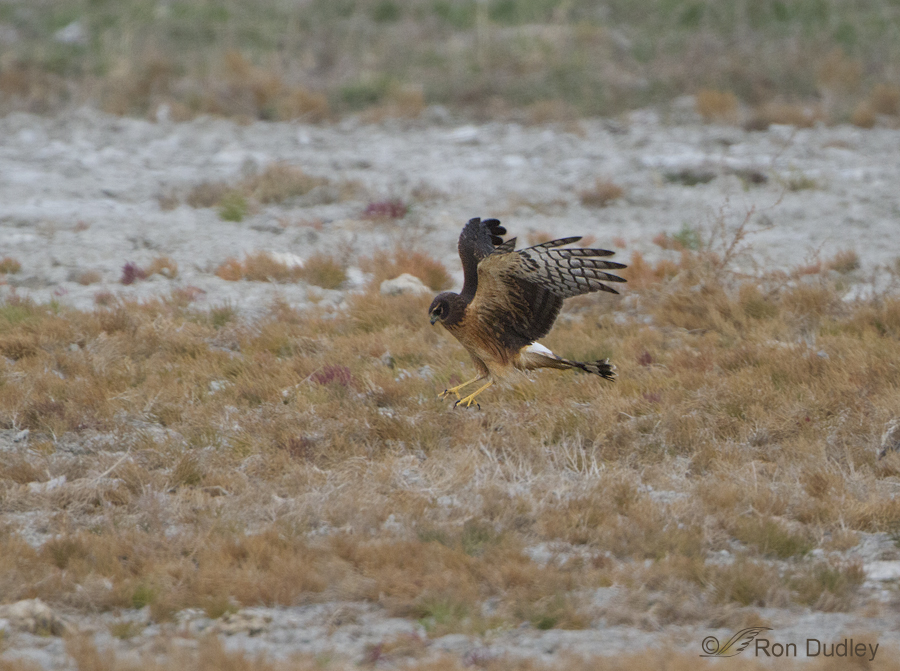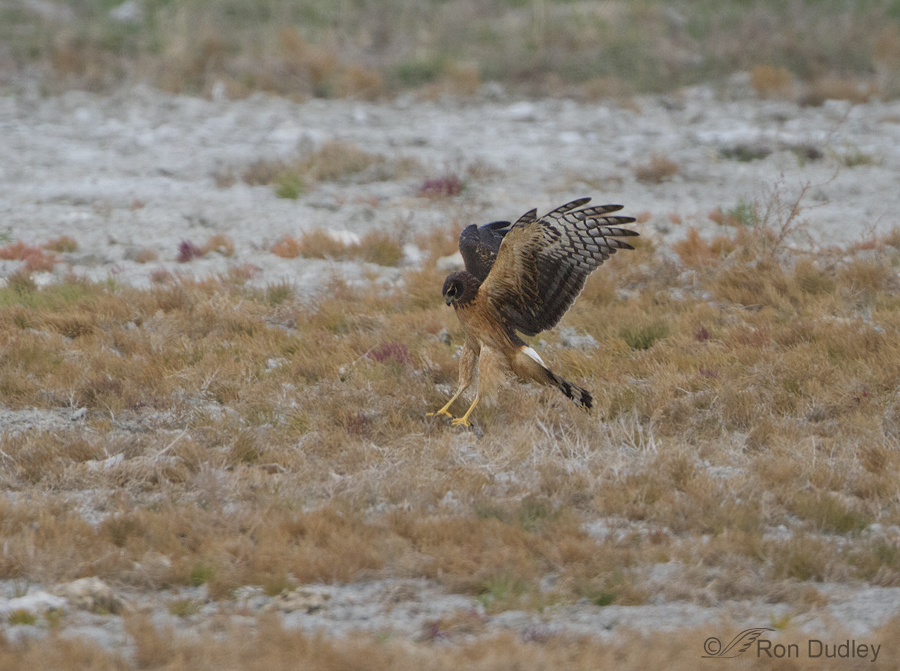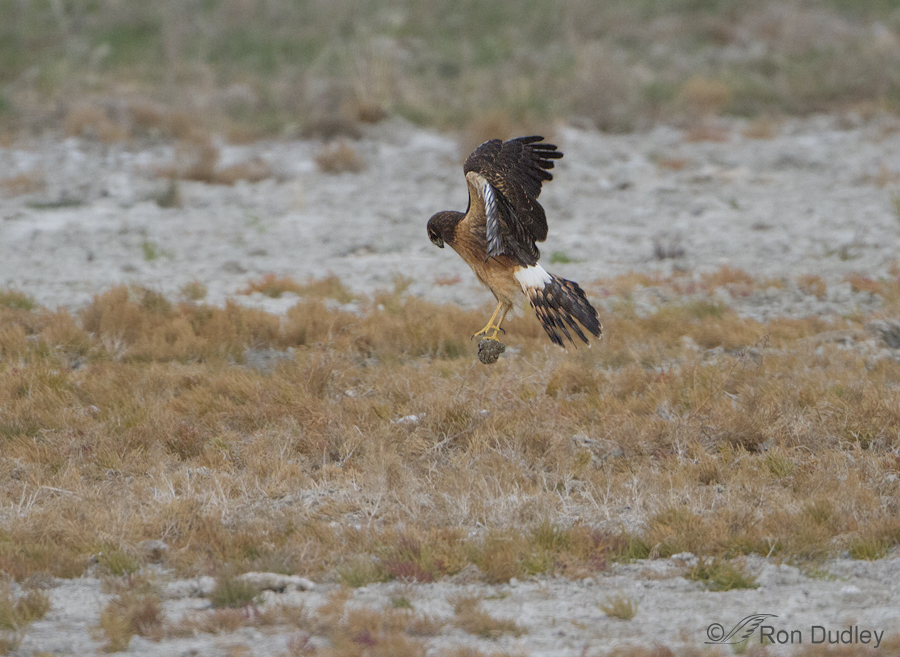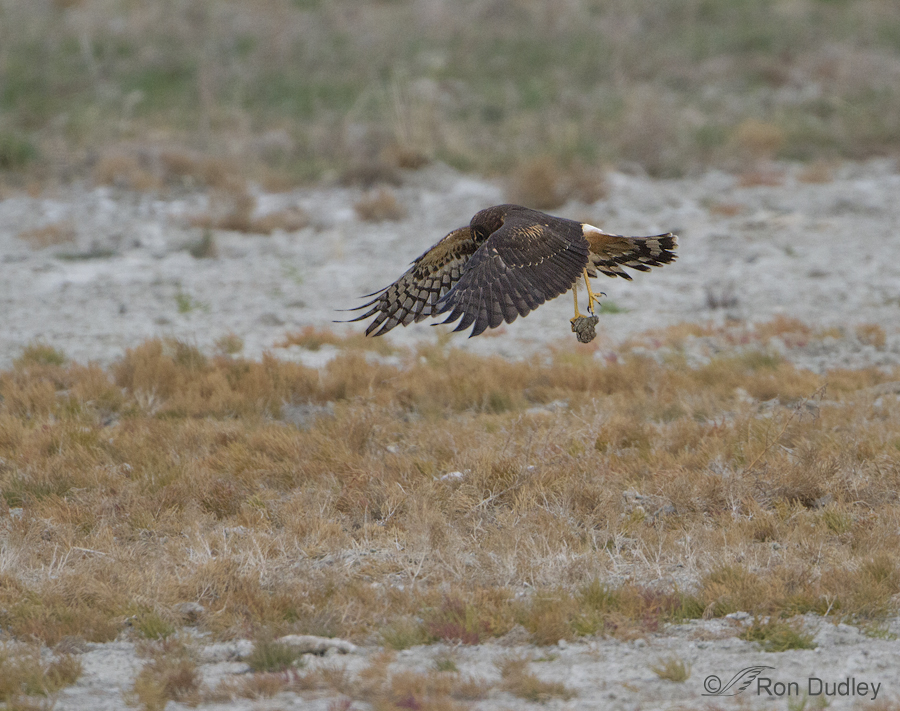Northern Harriers are occasionally known to play but it’s something I’ve seldom seen. Harriers are normally all business as they pursue simple survival in a harsh and unforgiving world but a week ago today I watched and photographed as one of these hawks had some apparent “fun”.
The bird was very far away and in marginal light so these images are of documentary quality at best,
At first I thought the harrier was chasing a vole on the ground but it soon became obvious that something else was going on. The bird repeatedly flew up from the ground a couple of feet…
and then pounced at something (several things) on the ground. From the timing of the pounces and the behavior of the bird it didn’t appear to be after moving prey. Each time it pounced it landed in a different spot, separated from the previous one by several feet. This went on for some time. At first I was watching it with the naked eye because I had to turn my pickup around to get my lens on the action and by the time that was accomplished this behavior was still occurring.
The harrier picked something up and dropped it and I believe that “something” was cow manure. Cattle spent much of the summer in this area of the refuge in an attempt (I believe) by managers to control Phragmites (more on that in my previous post).
The hawk played with the meadow muffin and other apparent objects on the ground that I couldn’t see through the vegetation for almost a minute before it flew off empty taloned.
Both fledgling and adult Northern Harriers are known to play with inanimate objects such as corncobs and other farming residue and play is more likely to be initiated when there’s another harrier nearby. In this instance there was another harrier very close to this one though the second bird never did join in the fun.
I’m fairly convinced that what I observed was play and though the image quality is poor I thought it worthy of a documentary blog post.
Ron






After reading this interesting post I realise I’ve seen it happen with a Swamp Harrier here. They would be a close relative of Northern Harriers I imagine. Well done getting the series so well.
Sonja: Your Swamp Harrier or Marsh Harrier, Circus aeruginosus is found almost world wide with the exception of the N.A. and Antarctica continents while our Northern Harrier (formerly Marsh Hawk and Hen Harrier in the rest of their range), Circus cyaneus, is found in much of Europe, N.A. and Asia as a breeder are related (same genus but different species) but quite difference in appearance (the males don’t have the degree of plumage color difference that our Northern Harrier displays (no sexual chromatism).
Bill
Thanks for putting that in, Bill. I didn’t have time to look it up last evening.
“Documentary quality’??? I understand where you’re coming from, but I think these shots are great. They are very clear and allow us to see something we would not otherwise get to see. Not every shot can be a portrait quality close-up. It is wonderful getting to see behaviors like this. The only time I’ve ever seen birds play was last spring when the young American Kestrels were playing in the wind one day, figuring out what they could do with it. It was wonderful to watch; too bad that’s the one thing we weren’t able to get video of.
Thanks, Susan.
I should explain my comment about image quality. Not only was this bird very far away (which allows very little detail) but I also significantly underexposed these images. That meant that I had to “bring them up” during processing, which always extracts a toll on image quality.
That’s what I meant about “documentary quality”.
I’m not sure we can assume birds are having fun when they are preforming an activity that we see as play. I believe it is simply a matter of them using an activity to develop or improve a skill. Us falconers often give our birds “toys” to allow them to work on their pouncing, footing and carrying skills. All requiring skills leading to their survival. Flight interaction between birds is also often a big part of the skill development, coordination and flight fitness.
A possible reason for the Harrier displaying “play” in the presents of other Harriers is a sense of competition, again a necessity often for their survival.
Bent wrote much about the behavior of raptors, in particular, with incredible accuracy long before our present day biologist or raptor researchers. Some of his writings are still available in used book stores or natural history specialty outlets.
Bill
“I’m not sure we can assume birds are having fun when they are preforming an activity that we see as play.”
I agree with you, Bill – I don’t think we can assume it either. That’s why I put the word “fun” in quotes. But perhaps doing even that was misleading to some.
Yes Ron, I understood the purpose of the quotation marks as well as around the word play. It is tempting to think of much of this in terms of what we know and experience ourselves rather than possibly thinking as much like the hawks or raptors might/do. I certainly think raptors experience and express some emotions. The challenge is knowing which and to what degree.
Bill
We can ONLY “assume” we truly “KNOW’ what ANY other creature is intending, thinking or feeling, including all other human beings…we still have NO ACCURATE WAY of ascertaining this information for sure/beyond doubt/in a scientifically verifiable way. How many times have we said or heard, “Oh! I thought you meant….” ,”or, That’s not what I meant….” , or, “I wonder what he/she meant….” etc. We “assume” all the time…so why not with birds, dogs, other creatures….?
Personally I think assuming they do can cause more harm than assuming they don’t until proven otherwise. I’ve seen far to many negative results from the former than the latter. Understanding, of course, we are not sure.
Bill
You’ve got a point….”Assuming” sure causes a lot of problems between us two-leggeds, doesn’t it…. For example: How often do we “assume” we’re correct about something…..
I don’t know what has me smiling more this morning. The play – or the meadow muffin. Thank you on both counts.
That’s what we always called them when I was a kid, Elephant’s Child. That or cow pies. Or some other things…
Really interesting behavioral shots! Since you mentioned this often occurs when another bird is near, are they showing off their abilities or just having fun. Do they need an observer to have fun? Hummm…..
It always amuses me that when you think your shots are poor quality, I would be so thrilled to get a shot of equal quality!
;.)
Charlotte
Thank you, Charlotte. Regarding your questions, see Bill Dove’s comment above. He’s more knowledgeable on the subject than I am.
Ron, your post triggered a memory so I went searching and found the following description in an article on the Northern Harrier:
“All at once the hawk dropped the lark, whereupon the latter, still alive flew weakly to the ground about seven feet away, its captor with outstretched talons hovering meanwhile about two and one-half feet above it but not pouncing upon it. When the lark reached the ground, the hawk lit beside it, then gave a little jump into the air and landed with spread talons upon its prey. It seemed not to bite the lark, but after examining it with many twistings and turnings of the head rose about three feet into the air with it, and then dropped it again, the lark still fluttering, and pounced upon it just as before. This the marsh hawk did seven or eight times, and I marveled at the clumsiness of the bird until I realized what was going on–it was playing.”
Original author: Arthur Cleveland Bent, published 1937, Smithsonian Institution United States National Museum Bulletin 167.
Great observation and photos!
Really an interesting read, Wally – thanks for providing it.
WOW! Love seeing this! And I learned a new term – “meadow muffin” – now to find a chance to use it in conversation today!!
Leisa…this bird is obviously playing with a meadow muffin. A cow pie would be too big…and flat. Now, a buffalo chip would be….
Once again, wonderful as the image/images are, the glimpse into bird behavior is invaluable…so many other creatures “play” and it’s so much fun to see…I wish I’d been there to see it myself. I’ve seen eagles play with things like sticks, passing them back and forth, dropping them and catching them…are they honing skills? Probably, but also appear to be having a good time doing it.
Thanks, Patty. I wish you could have seen it too. I really do…
Fascinating!!!! Practicing for birdie Olympics?? He’s a beauty!!!
Thank you, Lois.